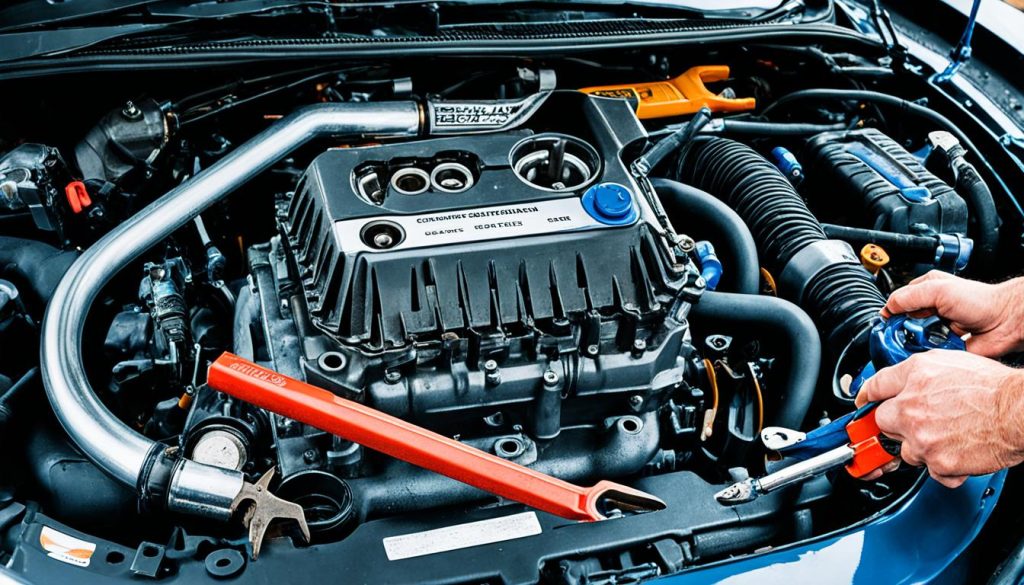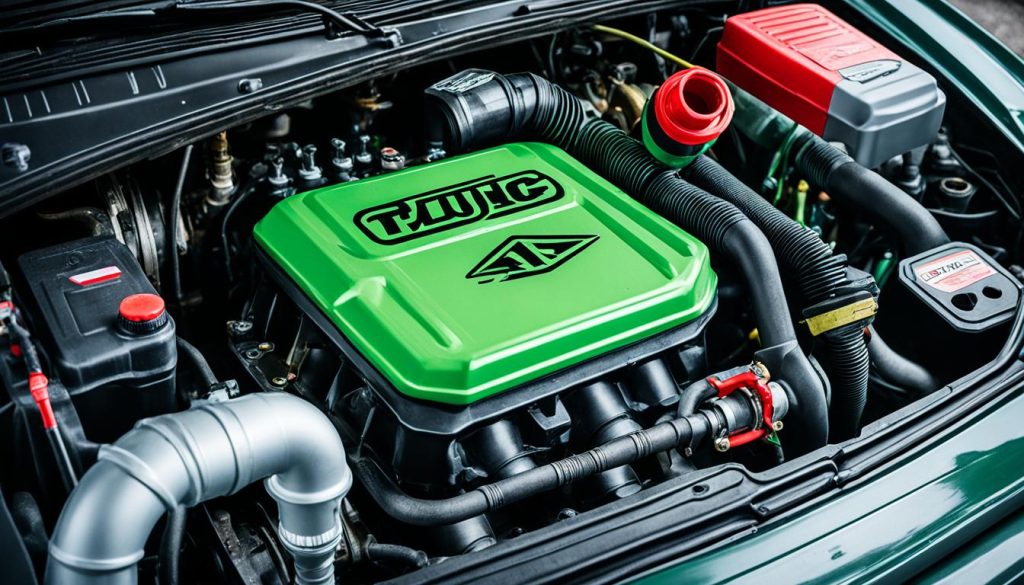Engine Block Coolant Drain Guide – How To Do It
Did you know that neglecting to drain the coolant from your engine block can lead to serious engine damage? It’s a maintenance task that often goes unnoticed, but it plays a crucial role in keeping your vehicle’s cooling system running smoothly. In this comprehensive guide, I will walk you through the step-by-step process of draining the coolant from your engine block, ensuring that you maintain an efficient cooling system and prevent any costly repairs.
Key Takeaways:
- Regularly draining the coolant from your engine block is essential for maintaining the efficiency of your vehicle’s cooling system.
- By following the step-by-step guide provided, you can prevent engine damage caused by accumulated dirt and debris.
- The tools you’ll need for draining coolant include a bucket, pliers or a wrench, a hose, and new coolant for refilling.
- Detaching the lower and upper radiator hoses, collecting the coolant in a bucket, flushing the system, and refilling with fresh coolant are the key steps in the process.
- Draining the coolant from the engine block should be done every two years or 40,000 miles to prevent blockages and ensure optimal engine performance.
Why Should You Drain The Coolant From The Engine Block?
Regular maintenance tasks, such as draining the coolant from the engine block, are crucial for the overall health and longevity of your vehicle’s cooling system. Failing to perform this maintenance task can lead to engine damage, reduced engine efficiency, and the accumulation of harmful build-up. Let’s take a closer look at why you should make draining the coolant from the engine block a priority.
Preventing Engine Damage
Over time, the cooling system in your vehicle can accumulate dirt, debris, and other contaminants. This buildup can obstruct the flow of coolant, leading to inadequate cooling and potential engine damage. Draining the coolant from the engine block helps remove these accumulated deposits, preventing blockages that could compromise the performance and reliability of your engine.
Optimizing Engine Efficiency
An efficiently operating cooling system is essential for optimal engine performance. When coolant becomes contaminated or loses its effectiveness, it cannot adequately cool the engine, resulting in decreased engine efficiency. By draining the coolant from the engine block, you can ensure that the cooling system is clean and free from any impediments, allowing it to function at its best.
Removing Accumulated Build-Up
Over time, coolant can break down, leaving behind residue and sediment. This accumulated build-up can restrict coolant flow, leading to poor heat transfer and increased risk of overheating. Draining the coolant from the engine block allows you to flush out this accumulated debris, promoting better heat dissipation and overall coolant system efficiency.
By draining the coolant from the engine block, you can maintain the health of your vehicle’s cooling system, prevent engine damage, and optimize engine efficiency. Regular maintenance tasks like this are important to ensure the longevity and reliability of your vehicle.
What Tools Do You Need To Drain The Coolant From The Engine Block?
When it comes to draining the coolant from the engine block, having the right tools is essential. Here are the necessary tools you will need to successfully complete the coolant drainage process:
- A bucket: This will be used to collect the coolant as it drains from the engine block.
- Pliers or a wrench: These tools will come in handy when removing the radiator hoses to allow the coolant to drain.
- A hose: You will need a hose to flush the system and ensure a thorough coolant drainage.
- New coolant: Once the old coolant has been drained, you will need new coolant to refill the engine block and ensure optimal performance.
Having these tools at hand will make the coolant drainage process much smoother and enable you to properly maintain your vehicle’s cooling system.
How To Drain Coolant From Engine Block?
Follow these steps to drain coolant from the engine block:
- Turn off the engine and allow it to cool.
- Locate the coolant drain plug on the rear of the engine block.
- Detach the lower radiator hose and collect the coolant in a bucket.
- Disconnect the upper radiator hose and use a hose to flush the system.
- Continue flushing until clear water runs out of the bottom of the engine.
- Refill the system with fresh coolant and reattach the hoses.
| Steps | Description |
|---|---|
| Step 1 | Turn off the engine and allow it to cool to a safe temperature before starting the coolant draining process. |
| Step 2 | Locate the coolant drain plug on the rear of the engine block. It is usually a valve or plug that can be opened to release the coolant. |
| Step 3 | Detach the lower radiator hose connected to the engine block and position a bucket beneath it to collect the draining coolant. |
| Step 4 | Disconnect the upper radiator hose from the engine block. This will allow for better system flushing later on. |
| Step 5 | Use a hose to flush the coolant system. Attach the hose to the upper radiator hose connection and flush the system until clear water runs out of the bottom of the engine. |
| Step 6 | Refill the cooling system with fresh coolant, following the manufacturer’s recommendations. Reattach the lower and upper radiator hoses securely. |
How Often Should You Drain The Coolant From The Engine Block?
Regular maintenance of your vehicle’s coolant system is crucial for its proper functioning and to prevent any potential blockages that can lead to engine damage. To maintain the efficiency of the cooling system and prevent blockages, it is recommended to drain the coolant from the engine block every two years or at 40,000-mile intervals, whichever comes first.
Regular coolant drainage helps remove any accumulated debris or contaminants that can hinder the cooling system’s performance. By following this maintenance schedule, you can ensure that your engine block remains clean and clear of any blockages that could compromise the engine’s efficiency.
Proper coolant system maintenance includes not only draining the coolant from the engine block but also flushing the system and refilling it with fresh coolant. This process helps prevent the build-up of debris and keeps the engine running smoothly.
Importance of Regular Coolant Drainage
Draining the coolant from the engine block at regular intervals is an essential maintenance task. It helps remove deposits, rust, and other contaminants that accumulate over time and can lead to blockages. By preventing blockages, you can ensure that the engine coolant flows smoothly through the system, maintaining optimal engine temperature and preventing overheating.
Regular coolant drainage also allows for a fresh and clean supply of coolant, which is important for the overall health and longevity of the engine. With clean coolant, the engine block remains free from debris and the risk of blockages is significantly reduced.
By following the recommended maintenance schedule and draining the coolant from the engine block every two years or 40,000 miles, you can prevent blockages and keep your vehicle’s engine running smoothly for years to come.
Can You Reuse The Old Coolant?
When it comes to the coolant in your engine block, reusing the old coolant is not recommended. While it may seem like a cost-saving measure, using old coolant can lead to serious issues and potential engine damage.
Old coolant can easily become contaminated with dirt, rust, and other debris that build up over time. This contamination can clog the cooling system and reduce its efficiency, preventing the coolant from effectively dissipating heat from the engine.
Moreover, the accumulated contaminants in the old coolant can cause damage to the engine components. The particles can circulate through the system, leading to increased wear and tear on vital parts.
Using fresh coolant when refilling the engine block is the best way to ensure optimal cooling system performance and prevent any potential damage. Fresh coolant is free from contaminants, providing the necessary protection for your engine.
By draining the old coolant from the engine block and replacing it with fresh coolant, you can maintain the efficiency and longevity of your vehicle’s cooling system. Always follow the manufacturer’s recommendations and use the appropriate coolant for your specific vehicle to ensure the best results.
| Old Coolant | New Coolant |
|---|---|
| Contaminated with dirt, rust, and debris | Free from contaminants |
| Reduced cooling system efficiency | Optimal cooling system performance |
| Potential engine damage | Enhanced engine protection |
How To Choose Coolant For Your Car?
Choosing the right coolant for your car is crucial to ensure optimal performance and prevent any potential damage to your vehicle’s engine. To make the best selection, I recommend visiting your car’s dealership. They have the expertise and access to the specific make and model of coolant that is recommended for your vehicle.
Car manufacturers often have specific coolant requirements based on the design and components of their engines. Using the correct coolant ensures compatibility and helps maintain the engine’s cooling system’s efficiency.
When you visit the dealership, provide them with the details of your car, including the make and model. They will be able to recommend the appropriate coolant that meets the manufacturer’s specifications. This ensures that the coolant is compatible with your car’s cooling system and doesn’t cause any potential issues or damage.
Dealership Recommendation
The dealership recommendation is valuable because they have access to the latest information regarding coolant compatibility and any specific requirements for your car. They can guide you towards the coolant that will provide the best protection and performance for your vehicle.
Additionally, using the recommended coolant from the dealership helps maintain your car’s warranty coverage. Using a non-approved coolant may void your warranty, leaving you responsible for any potential repairs or damages.
Here is an example of a table that showcases the different coolant specifications for some popular car models:
| Car Model | Recommended Coolant |
|---|---|
| Honda Civic | Honda Long Life Coolant |
| Toyota Camry | Toyota Super Long Life Coolant |
| Ford Mustang | Ford Motorcraft Gold Coolant |
Always refer to your car’s owner’s manual or consult with your dealership for the specific coolant recommendation for your vehicle.
Choosing the correct coolant for your car is an essential step in maintaining the performance and longevity of your vehicle’s engine. By following the dealership’s recommendation and using the coolant specifically designed for your car’s make and model, you can ensure optimal coolant compatibility and efficient cooling system operation.
Conclusion
Proper maintenance of the coolant system, including regularly draining the coolant from the engine block, is vital for ensuring the efficient operation of your vehicle’s cooling system and preventing potential engine damage. By following the manufacturer’s recommendations and performing this essential maintenance task, you can significantly extend the longevity of your engine and ensure an efficient cooling system.
Regularly draining the coolant from the engine block helps to remove accumulated dirt, debris, and contaminants from the cooling system, which can impede its performance. This process allows for the efficient flow of coolant, preventing any blockages and ensuring that the engine stays cool during operation.
To prevent engine damage and maintain an efficient cooling system, it is crucial to follow the manufacturer’s recommendations for coolant maintenance, including the frequency of coolant drainage. By adhering to these guidelines, you can avoid costly repairs and keep your vehicle’s engine running smoothly for years to come.
- Investing Wisely: How Windows & Doors in Boost Property Value and Financial Health - April 24, 2025
- The Financial Impact of Personal Injuries: Why Legal Help Matters for Business Owners - April 16, 2025
- The Hidden Financial Costs of Domestic Assault: What Business Owners Need to Know - April 16, 2025














